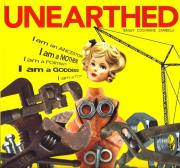Doug Bailey
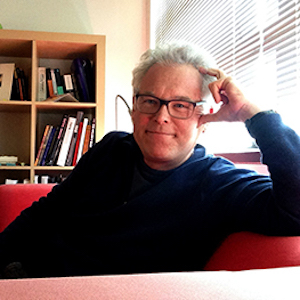
Email dwbailey@sfsu.edu for zoom link
Tuesday: 10:00 am-4:00 pm
Wednesday: 10:00 am-4:00 pm
Thursday: 10:00 am-4:00 pm
Friday: 10:00 am-4:00 pm
Biography
- Professor of Visual Archaeology, SF State, 2008-present
- Professor of Archaeology, Cardiff University, 1993-2007
- Ph.D. Cambridge University, 1991
- M.Phil Cambridge University, 1986
- A.B. Dartmouth College, 1985
(for more details, see full CV at the bottom of this page)
Teaching and Research Interests
Art and Visual Culture, Prehistoric Art, Archaeology, Representation, and The Archaeology of the Contemporary Past
My interests range widely. Current focus is on the archaeology of art and visual culture and on art/archaeology as alternative production. Work is at the interface of art and archaeology, as well as in the challenging space beyond both disciplines. Intentions are to reposition our approaches to prehistoric visual culture and to create radical alternatives to archaeological publication (e.g., the Unearthed book; see blurb below). Graduate applicants wishing to explore these topics are invited to contact me before submitting their formal applications. Other interests: the anthropological, archaeological, and visual archive; Surrealist periodicals; DADA; early 20th century photography; and the prehistoric archaeology of Europe. Please see my photo work made about rural Romania and about the charlatan healer John of God. Scroll to the bottom of this webpage to find a link to my current CV. Almost all of my journal articles and book chapter are available from academia.edu. For more on art/archaeology see brief details below and more extended treatment at www.artarchaeologies.com.
Books
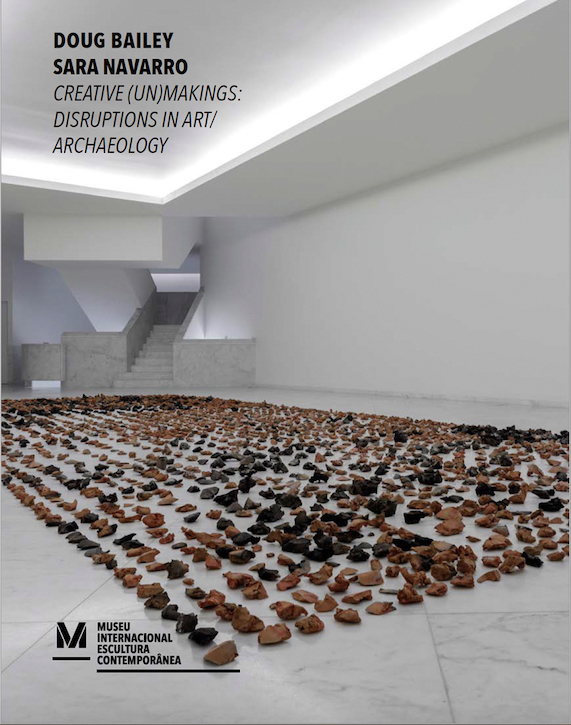 Bailey, D.W., S. Navarro and A. Moreira. 2020. Creative (un)makings: Disruptions in Art/Archaeology. Santo Tirso: International Museum of Contemporary Art.
Bailey, D.W., S. Navarro and A. Moreira. 2020. Creative (un)makings: Disruptions in Art/Archaeology. Santo Tirso: International Museum of Contemporary Art.
Art/archaeology, a new transdisciplinary practice has fractured traditional perspectives on the relationships of art and archaeology, and the exhibition "Creative (un)makings" brings that disruption to the museum world for the first time. This book is the catalogue from the exhibition at the International Museum of Contemporary Sculpture in Portugal (March-September 2020).
Download a pdf of Creative (un)makings.
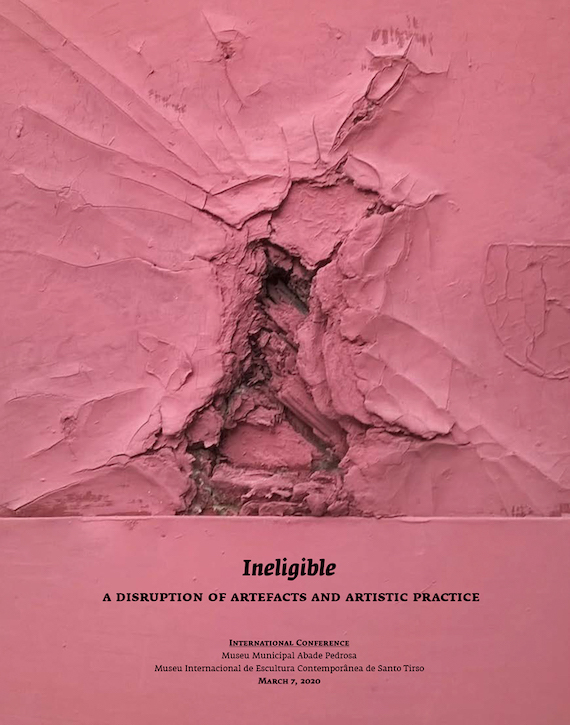 Bailey, D.W., S. Navarro, and A. Moreira (eds). 2020. Ineligible: A Disruption of Artefacts and Artistic Practice of Art. Santo Tirso: International Museum of Contemporary Sculpture.
Bailey, D.W., S. Navarro, and A. Moreira (eds). 2020. Ineligible: A Disruption of Artefacts and Artistic Practice of Art. Santo Tirso: International Museum of Contemporary Sculpture.
This volume of essays derives from the conference held in March 2020 at the International Museum of Contemporary in Portugal in association with the exhibition, "Creative (un)makings: Distruptions in Art/Archaeology". This book suggests that one way forward is to explore the potentials of an art/archaeology. The proposal is that we should move beyond traditional efforts to explain or interpret the past, and that we do this in a creative way that has impact on contemporary societies.
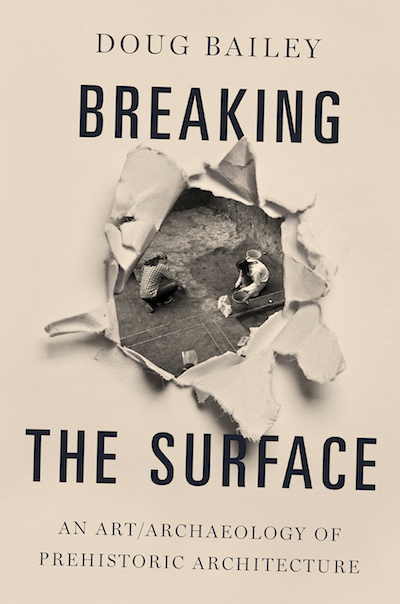 Bailey, D.W. 2018. Breaking the Surface: An Art/Archaeology of Prehistoric Architecture. Oxford: University of Oxford Press.
Bailey, D.W. 2018. Breaking the Surface: An Art/Archaeology of Prehistoric Architecture. Oxford: University of Oxford Press.
Breaking the Surface offers a radical alternative for understanding Neolithic houses, providing much-needed insight not just into prehistoric practice, but into another way of doing archaeology. Using my fieldwork experience excavating the early Neolithic pit-houses of southeastern Europe, I expose and elucidate a previously under-theorized aspect of prehistoric pit construction: the actions and consequences of digging defined as breaking the surface of the ground.
Critical comment and reviews:
"Remarkable and original. A marvelous book full of wonderful associations. A fabulous excursion in the archaeological imagination. Doug Bailey offers us a profound reshaping of the way we see the world." (Michael Shanks, Professor, Stanford University).
"It is very rare that one sees a book about prehistory that is truly revolutionary or relevant beyond the field. Doug Bailey has produced one. With his subversive mixture of contemporary art and archaeological practice, he forces us to see the world anew-that of early farmers and our own era. And in the process, he reinvents archaeology." (Alfredo González-Ruibal, Institute of Heritage Sciences of the Spanish National Research Council).
"A terrific tool for teaching the ways in which different disciplines can contribute to the interpretive elaboration of archaeology. It constantly inspires ideas and stimulates thoughts well beyond its pages….an extraordinary tour de force that brings disciplines together—some well beyond archaeology’s immediate lateral thinking.” (Ruth Tringham [UC Berkeley] in Journal for Anthropological Research, Winter 2019).
"An outstanding and stimulating book, filled with original ideas and thoughtful reflections, and as such it can be thoroughly recommended. Bailey’s engagement with art history and art criticism is deep, scholarly and productive." (Julian Thomas [Manchester University] in Proceedings of the Prehistoric Society, February 2019).
"A fresh and bold contribution that goes beyond disciplinary boundaries....novel and intriguing inspirations for the study of art. The first step in inaugurating a new field of research, spreading from archaeology to art history, disrupting and complicating the previous studies and interpretations offered by both disciplines. Highly recommended to all scholars interested in cutting-edge perspectives that complicate previous studies and encourage to question the state of art, both in archaeology, anthropology, and art history." (Monika Stobiecka [University of Warsaw)] in Norwegian Archaeological Review, August 2020).
"A valuable contribution to archaeology’s recent engagements with visual art….a demonstration of the insights provoked by the new sub- discipline, Art/Archaeology." (Helen Wickstead [Kingston University, London] in European Journal of Archaeology, May 2020).
Bailey, D.W. (with A. Cochrane and J. Zambelli). 2010. Unearthed: a Comparative Study of Jomon Dogu and Neolithic Figurines. Norwich: Sainsbuty Centre for Visual Arts.
This book interrogates the traditional ways that museums and archaeologists work together in the presenting artifacts and modern popular culture. Connected to the (Un)earthed exhibition at the Sainsbury Centre in the UK, the book is less an catalogue or research monograph than it is a meditation on excavation and archaeological endeavor. The book forces the reader, spectator, and exhibition viewer to take up the job of archaeologist. As you excavate this book and encounter its artifacts, you will wrestle with unexpected evidence, opinion, and comporanda: from prehistoric figurines to Barbie-Dolls.
Critical comment and reviews:
“Unearthed was the most open-ended and radical exhibition…It is what we should expect of a university’s production. Nobody can forget it.” (Nicholas James, Cambridge University)
“Brilliant….Unearthed is a unique endeavor into the topic of Neolithic anthropomorphic imagery and representations coming from Douglass Bailey, one of the leading authorities on the subject.” (Miloš Spasić [Belgrade City Museum], Journal of the Serbian Archaeological Society).
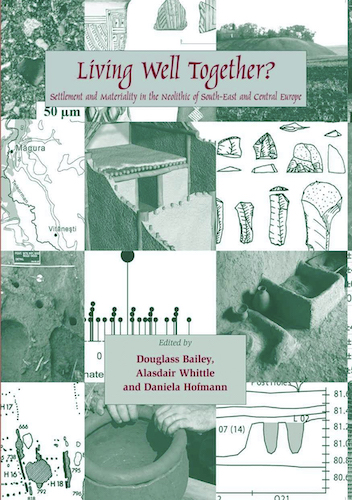 Bailey, D.W., A. Whittle and D. Hofmann (eds) 2008. Living Well Together: Sedentism and Mobility in the Balkan Neolithic. Oxford: Oxbow.
Bailey, D.W., A. Whittle and D. Hofmann (eds) 2008. Living Well Together: Sedentism and Mobility in the Balkan Neolithic. Oxford: Oxbow.
Living Well Together investigates the development of the Neolithic in southeast and central Europe from 6500-3500 cal BC with special reference to the manifestations of settling down. This book provides 14 tightly written and targeted papers presenting interpretive discussions from important excavations and reassessments of our understanding of the Neolithic. Each paper makes a significant contribution to existing knowledge about the period, and the book, like its companion (Un)settling the Neolithic (Oxbow 2005) will be a benchmark text for work in this region. The volume's authors have succeeded in attacking existing thought, in provoking new discussion and in creating new paths to understanding the nature of human existence in the Neolithic. Together they set a new agenda for studying the Neolithic across and beyond southeastern and central Europe.
Critical comment and reviews:
“Fundamental for our understanding of space and place, and “being” in the Neolithic. The editors and authors…have succeeded in highlighting the need for multidisciplinary approaches to a diverse archaeological record in order to generate meaningful and realistic narratives of the past”. (Malcom Lille [Umeå University] Antiquity)
“A valuable collection”. (Lolita Nikolova, European Journal of Archaeology)
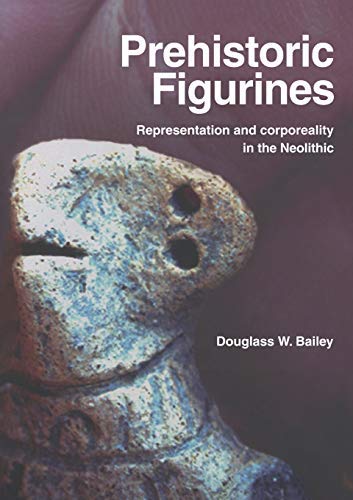 Bailey, D.W. 2005. Prehistoric Figurines: Representation and Corporeality in the Neolithic. London: Routledge.
Bailey, D.W. 2005. Prehistoric Figurines: Representation and Corporeality in the Neolithic. London: Routledge.
Prehistoric Figurines brings a radical new approach to one of the most exciting, but poorly understood artefacts from our prehistoric past. Studying the interpretation of prehistoric figurines from Neolithic southeast Europe, Bailey introduces recent developments from the fields of visual culture studies and cultural anthropology, and investigates the ways in which representations of human bodies were used by the pre-historic people to understand their own identities, to negotiate relationships and to make subtle political points. The study travels beyond the traditional mechanisms of interpretation and takes the debate past the out-dated interpretations of figurines as Mother-Goddess as Bailey examines individual prehistoric figurines in their original archaeological contexts and views them in the light of modern exploitations of the human form.
Order Prehistoric Figurines from Amazon.
Critical comment and reviews:
“There is certainly much of interest here, Many of the sources that Bailey brings to bear are completely novel to existing scholarship on prehistoric figurines, and they yield some real insights. The book itself is engagingly written and well-illustrated. Discussions of the diverse sources make for a lively read.” (Richard Lesure [UCLA], Cambridge Archaeological Journal)
“Whatever you know about prehistoric figurines, this book will open your eyes and make you think... Bailey helps the reader all the way, with a meticulously constructed text, written in an absorbing style; it combines some closely observed descriptions of the forms of figurines with comprehensive syntheses of their archaeological contexts, critical reviews of previous studies and interpretations, accessible explanations of complex ideas about human representation, and a selection of photographs and line drawings that work actively alongside the text... this is an outstanding book, because it poses so many thought-provoking questions about the complex qualities of visual representations of human bodies in the past and their significance today.” (Robin Skeates [Durham University], Antiquity)
“Bailey’s daring, refreshing, and original approach consists of new questions, including subjects that are not normally associated with the Balkan Neolithic or prehistoric archaeology but rather the modern world.” (Christina Marangou, European Journal of Archaeology).
“The uncompromising cut-and-thrust that is a hallmark of Bailey’s previous work on figurines reaches new peaks in the criticism of any previous understanding of figurines, before opening up a whole new world of visual culture to welcome and comfort us in what may seem a radically new approach to figurines.” (Bisserka Gaydarska, Proceedings of the Prehistoric Society)
“Always inspiring….very stimulating to read and points far beyond the traditional interpretation of figurines as allegories of fertility…[T]he book goes much farther than many other studies; that alone is its greatest payoff.” (Raiko Krauss [University of Tübingen] Praehistorishe Zeitschrift).
“Something extraordinary. A work of visual art on its own.” (Krum Bacvarov and Valeska Becker, Sudia Praehistorica)
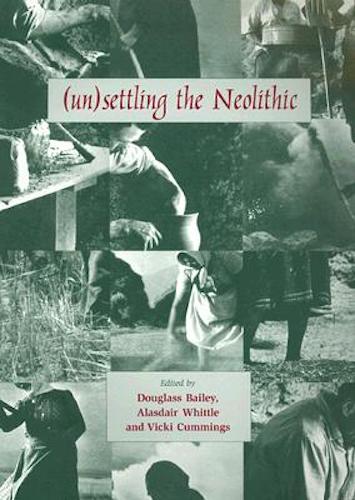 Bailey, D.W., A. Whittle and V. Cummings (eds) 2005. (un)settling the Neolithic. Oxford: Oxbow.
Bailey, D.W., A. Whittle and V. Cummings (eds) 2005. (un)settling the Neolithic. Oxford: Oxbow.
This book takes a fresh look at the European Neolithic and asks pertinent questions about the way in which we study it. By unsettling accepted notions regarding sedentism and the onset of farming, the contributors are able to sow that many ideas which are taken as read may need re-evaluating in the light of new modes of thinking. Sedentism and mobility form the bulk of this volume's focus, and a number of papers look at these concepts through examining/re-examining certain sites or collections of sites. Paul Halstead makes the case that sedentism does not preclude a large degree of mobility. Bailey asks us to completely re-think our attitude to the built environment of the Neolithic, arguing that we are trapped by details as to the purpose of structures, rather than on what effect their presence had on the people who used them. Taken together, these fourteen papers encourage us to move beyond the search for sedentism or mobility as a characteristic of society.
Critical comment and reviews:
“(Un)settling the Neolithic presents a radical redirection in the study of the central and east European Neolithic, attacking the essentialisms of traditional approaches to the perod.” (Malcom Lille [Umeå University] Antiquity)
 Bailey, D.W. 2000. Balkan Prehistory: Exclusion, Incorporation and Identity. London: Routledge.
Bailey, D.W. 2000. Balkan Prehistory: Exclusion, Incorporation and Identity. London: Routledge.
Balkan Prehistory fills the huge gap that existed for a comprehensive synthesis, in English, of the archaeology of the Balkans between 6,500 and 2,000 BC; much research on the prehistory of Eastern Europe was inaccessible to a western audience before now, because of linguistic barriers. Bailey argues against traditional interpretations of the period, which focus on the origins of agriculture and animal breeding. He demonstrates that this was a period when monumental social and material changes occurred in the lives of the people in this region, with new technologies and ways of displaying identity.
Critical comment and reviews:
“A remarkable summary of the work that has been done in the field in the last four decades…Meets the goals set brilliantly. The arguments are thought provoking…and refreshing…the best commendation a reviewer can give.” (Andreas Hemming, Anthropos)
“Thorough…stimulating. A valuable contribution to Balkan prehistory. Bailey makes many strong points about new ways of seeing things. a very valuable synthesis for undergraduates, postgraduates and specialists alike.” (John Chapman [Durham University], European Journal of Archaeology).
Projects
Releasing the Visual Archive
This project investigates the status of the visual archive with particular attention to the complexities of the image as object and the politics of visual culture. A first study in the project (The Book of Miko) has been an examination of over 1200, 35-mm colour transparencies that a museum curator discarded immediately before the closure of her collection. With the support of the Norwegian Academy of Sciences, the study uncovered unexpectedly disturbing sets of image subjects; most slides depicted animals in captivity (and being dissected), face and head shapes of immigrant populations, highly sexualized representations of pregnancy and birth, and human fossil remains. Hard-edged conflicts emerged about how to handle these slides; standard visual anthropological practice of repatriation was not applicable as human subjects could not be sourced and animal subjects and fossil remains stood outside of standard categories of communicative agents. The study wrestled to negotiate an ethical treatment of morally questionable visual artifacts. One study product was a set of five photobooks in which I juxtaposed image-sets in order to raise difficult questions about the appropriateness of scholarly imagery. A second study output, more performative and provocative, was to release the images from their archival constraints through their destruction by combustion and chemical dissolution.
For full details see my 2020 chapter "Releasing the visual archive: on the ethics of destruction" in After Discourse: Things, Affect, Ethics, edited by B. Olsen, M. Burstrøm, C. DeSilvey, and Th. Pétursdóttir (London: Routledge). Also see the essay "Releasing the archive" about my 2020 installation of the same name at the International Museum of Contemporary Sculpture in Portugal in the exhibition catalogue, Creative (un)makings: Disruptions in Art/Archaeology, edited by D. Bailey, S. Navarro, and Á. Moreira, and published by the museum.
You can see a short lecture that I gave in 2017 at Rutgers University for their Cultural Heritage and Preservation Studies center at a conference about heritage and the visual archive that I titled Accelerated Decay and the Release of the Confined: Destroying a Visual Archive (you need to scroll to the 2 hour and 22 min mark of the video - or you could watch the entire conference if you want to)
Select project publications:
- Bailey, D.W. 2017. The Book of Miko. Volume 4, number 4 (Reproduction and Fossil). San Francisco, CA.: Blurb. (Order this book as a PDF or print Book of Miko 4/4)
- Bailey, D.W. 2017. The Book of Miko. Volume 8, number 3 (Subjects and Dissection). San Francisco, CA.: Blurb. (Order this book as a PDF or print Book of Miko 8/3)
- Bailey, D.W. 2017. The Book of Miko. Volume 17, number 1 (Ethnicity and Sexuality). San Francisco, CA.: Blurb. (Order this book as a PDF or print Book of Miko 17/1)
- Bailey, D.W. 2017. The Book of Miko. Volume 23, number 6 (Grid and Classification). San Francisco, CA.: Blurb. (Order this book as a PDF or print Book of Miko 23/6)
- Bailey, D.W. 2017. The Book of Miko. Volume 43, number 6 (Release and Destroy). San Francisco, CA.: Blurb. (Order this book as a PDF or print Book of Miko 43/6)
- Bailey, D.W. 2020. Releasing the visual archive: on the ethics of destruction. In B. Olsen, M. Burstrøm, C. DeSilvey, and Th. Pétursdóttir (eds) After Discourse: Things, Affect, Ethics, pp. 232-56. London: Routledge.
- Bailey, D.W. 2020. Releasing the archive. In D. Bailey, S. Navarro, and Á. Moreira (eds) Creative (un)makings: Disruptions in Art/Archaeology, pp. 18-23, 58-63. Santo Tirso: International Museum of Contemporary Sculpture.
Art/Archaeology
Through alternative output of traditional materials, I have been working in a new space beyond the disciplinary definitions and boundaries of art and archaeology. The concern is not to interpret the art of the past or assign meaning to actions of past peoples; the intent is to create new work using the past and its remnants as material and resource, as palette and medium. The project practices a dissident archaeology through the visual and creates provocative output. View the fall 2019 lecture that I gave at UC Berkeley's Archaeological Research Facility. In 2020, at the International Museum of Contemporary Sculpture in Santo Tirso, Portugal, I curated (with Sara Navarro) the exhibition Creative (un)makings: Disruptions in Art/Archaeology. One of the three components of this exhibition, Ineligible, was a major installation of art/archaeology in action. Details are included both in the exhibition catalogue Creative (un)makings: Disruptions in Art/Archaeology, edited by D. Bailey, S. Navarro, and Á. Moreira, but also by the publication of essays inspired by a conference associated with the exhibition: Ineligible: A Disruption of Artefacts and Artistic Practice, also edited by D. Bailey, S. Navarro, and Á. Moreira.
Follow the latest work in Art/Archaeology and find updated lists of publications and events on the Art/Archaeology site, and join the discussion by joining the Art/Archaeology FaceBook group.
Select project publications:
- Bailey, D.W., Cockrane, A. and Zambelli, J. 2010. Unearthed. Norwich: Sainsbury Centre. Order this book.
- Bailey, D.W. 2012. Cutting the earth / cutting the body. In A. González-Ruibal (ed.) Reclaiming Archaeology: Beyond the Tropes of Modernity, pp. 337-45. London: Routledge. Access this article from my academia.edu page.
- Bailey, D.W. 2014. Which ruins do we valorize? A new visual calibration for the Balkan past. In B. Olsen and Þ. Pétursdóttir (eds) Ruin Memories: Materiality, Aesthetics and the Archaeology of the Recent Past, pp. 215-29. London: Routledge. Access this article from my academia.edu page.
- Bailey, D.W. 2014. Art // archaeology // art: letting-go beyond. I. Russell and A. Cochrane (eds), Art and Archaeology: Collaborations, Conversations, Criticisms, pp. 231-50. New York: Springer-Kluwer. Access this article form my academia.edu page.
- Bailey, D.W. and Simpkin, M. 2015. Eleven minutes and forty seconds in the Neolithic: underneath archaeological time. In R. Van Dyke and R. Berneck (eds) Subjects and Narratives in Archaeology, pp. 187-213. Boulder, CO.: University of Colorado Press. Access this article from my academia.edu page.
- Bailey, D.W. 2017. Disarticulate – repurpose – disrupt: art/archaeology. Cambridge Archaeological Journal 27(4): 691-701. Access this article from my academia.edu page.
- Bailey, D.W. 2017. Art/Archaeology: what value artistic-archaeological collaboration? Journal of Contemporary Archaeology 4(2): 246-256. Access this article from my academia.edu page.
- Bailey, D.W. 2018. Breaking the Surface: an Art/Archaeology of Prehistoric Architecture. Oxford: Oxford University Press.
- Bailey, D.W. 2020. Art/archaeology: the Ineligible project. In D.W. Bailey, S. Navarro, and Á. Moreira (eds) 2020. Ineligible: A Disruption of Artefacts and Artistic Practice. pp. 13-28. Santo Tirso: International Museum of Contemporary Sculpture.
- Bailey, D.W., Navarro, S and Moreira, Á. (eds) 2020. Ineligible: A Disruption of Artefacts and Artistic Practice. Santo Tirso: International Museum of Contemporary Sculpture.
Select project installations:
- 2020 Releasing the Archive. International Museum of Contemporary Sculpture, Santo Tirso, Portugal. March-September [photographic, video, transparency projection].
- 2020 Ineligible - Santo Tirso. International Museum of Contemporary Sculpture, Santo Tirso, Portugal. March-September [curation, 25 contributors].
- 2020 Creative (un)makings: Disruptions in Art/Archaeology. International Museum of Contemporary Sculpture, Santo Tirso, Portugal. March-September. [co-curator with Sara Navarro].
- 2015 Ancient Figurines: Controlling Bodies. Badé Museum of Biblicial Archaeology, Berkeley, California. June – September [photographic / mixed media].
- 2010. Unearthed. Norwich: Sainsbury Centre for Visual Arts June-Octo. [prehistoric / contemporary material culture].
Present-Past-(Re)presentation: Romania
With Dr. Steve Mills (Cardiff University, UK), I was co-PI of a European Union project (£300,000 / $477,829) investigating cross-disciplinary approaches to art and the landscape. Basing our work on the modern village of Măgura, in southern Romania, the project wrestled with issues of representation and documentation. Using a diverse set of methods and approaches the project created multi-media, multi-period interpretations of a rural community which has been a center of rural life for over 8000 years. Participants ranged from archaeologists, historians, ethnographers, land artists, photographers and ethnographic film-makers to local school children, politicians, shop-keepers and village residents.
Select project publications:
- Biella, P. and Druvofka, I. 2010. Eternity Was Born in the Village. Philadelphia and San Francisco: Bilingual Media.
- Jasmin, M. 2010. The Brain of the Archaeologist. Paris: Deux Ponts.
- Mills, S. 2010. Interventions: Margura Past and Present. Cardiff: Cardiff University.
- Mirea, P. 2010. The Lower Danube in Prehistory. Bucuresti: Renaissance.
- Thorne, S. 2010. Some Spaces. Cardiff: Thorne Music.
- Thorne, S. 2010. Romanian Village Soundscape. Cardiff: Thorne Music.
- Tsantareanu, E. and Nemteanu, R. 2010. Human Cultural Change in the Romanian Rural Landscape. Bucuresti: Renaissance.
The Interpretation of Prehistoric Art
A long-running project has been the critical reassessment of prehistoric art, specifically the smal anthropomorphic figures of Neolithic central and southeastern Europe (6500-3500 cal. BC). Through a series of publications, I have argued that we must understand representations of art not as simple representations of past realities (i.e., as Goddesses or evidence of matriarchy), but as subtle, but powerful elements through which identities and relationships of appearance emerge, change, are manipulated, and lead to unintended consequences. Issues of stereotypes, origins of the gendered body, the materiality of fired clay and the rhetoric of representation are all in play.
Select project publications:
- Bailey, D.W. 2005. Prehistoric Figurines: Representation and Corporeality. London: Routledge. Order this book.
- Bailey, D.W. 2009 The figurines of Old Europe. In D.W. Anthony (ed.) The Lost World of Old Europe: The Danube Valley 5000-3500 BC, pp. 112-27. New York: NYU and Princeton University Press. Access this article from my academia.edu page.
- Bailey, D.W. 2010. Prehistoric Art. In M. Stokstad and M. Cothren (eds.) Art History (4th edition), pp. 1-26. New York: Pearson/Prentice Hall. Access this article from my academia.edu page.
- Bailey, D.W. 2012. Figurines, corporeality and the origins of gender. In D. Bolger (ed.) Companion to Gender Prehistory, pp. 244-64. Oxford: John Wiley. Access this article from my academia.edu page.
- Bailey, D.W. 2014. Touch and the cheirotic apprehension of prehistoric figurines. In P. Dent (ed.) Sculpture and Touch, pp. 27-43. London: Ashgate. Access this article from my academia.edu page.
- Bailey, D.W. 2017. Southeast European Neolithic figurines: beyond context, interpretation, and meaning. In T. Insoll (ed.) The Oxford Handbook of Prehistoric Figurines, pp. 823-50. Oxford: Oxford University Press. Access this article from my academia.edu page.
Spirits of Clay: Jomon and European Figurines
With Dr. Simon Kaner (University of East Anglia, UK), I coordinated a series of museum exhibitions and academic symposia. The project brought together prehistoric figurines from two of the world’s great traditions: the Japanese Jomon and the East European Neolithic. Through an exhibition at the British Museum (winter 2009/10) and the Sainsbury Centre for Visual Arts (spring 2010), the project assembled some of the world's outstanding examples of prehistoric art. Each exhibition complemented an academic symposium at which archaeologists, anthropologists, creative and visual artists presented new interpretations and approaches and debate questions of explanation and meaning. Major funding was provided by the Arts and Humanities Research Council (UK) [£349,500 / $689,878] and a range of public organizations in Europe and Japan.
Select project publications:
- Bailey, D.W. 2009. The Chobonaino Dogu: understanding a Late Jomon figure from Hakodate. In S. Kaner (ed.) The Power of Dogu, pp. 60-9 London: British Museum Press.
- Bailey, D.W., Cochrane, A. and Zambelli, J. 2010. Unearthed: a Comparative Study of Jomon Dogu and Neolithic Figurines. Norwich: Sainsbury Centre for Visual Arts.
Contested Histories of Angel Island
With Professor Peter Biella and film-makers Daniel Chein and Kelly Grabianowsky, I produced a film about the multiple histories and understanding of the Angel Island in the San Francisco Bay. The project aims to educate students, teachers and community members about the multicultural history of the Bay Area by focusing on the contested heritage of Angel Island, best know as the Ellis Island of the west. Contested Histories provides a unique forum for multiple perspectives on the past as it has been created and as it continues to be constructed, reconstructed and exploited. The project is supported by the generous funding of the Farnley Tynas Foundation.
Select project publications:
- What Was Angel Island? (DVD; 13:20 mins).
Southern Romania Archaeological Project
With Dr. Radian Andreescu (National Museum of History, Bucureşti), I am co-Principal Investigator of a multi-national excavation project (50-70 person team) in southern Romania. The Southern Romania Archaeological Project (SRAP) started in 1998. The project investigates the origins and consequences of sedentism from 8000-2500 BC along the Teleorman River, a Danube tributary. SRAP is a collaboration between Cardiff University, the National Historical Museum of Romania and the Teleorman Regional Historical Museum in Alexandria (Romania). Participants are drawn from the University of Wales at Aberystwyth (Mark Macklin, Tom Coulthard), Nottingham (Amy Bogaard), St. Andrews (Ruth Robinson), Sheffield (Mike Charles, Rob Craigie), Bristol (Richard Evershed) and Leiden (Laurens Thissen). Funding has come from UK (British Academy, Society of Antiquaries of London) and Romanian sources (Ministry of Culture, Teleorman County Council).
Select project publications:
- Bailey, D.W., Andreescu, R., Howard, A.J., Macklin, M.G. and Mills, S. 2002. Alluvial landscapes in the temperate Balkan Neolithic: transitions to tells. Antiquity 76: 349-55.
- Bailey, D.W., Howard, R., Macklin, M., Andreescu, R. and Mills, S. 2003. The origins of villages in the Balkan Neolithic and the alluvial history of a Danube tributary. In A. Howard, D. Passmore and M. Macklin (eds) Alluvial Archaeology, pp. 24-43. Rotterdam: Brill.
- Bailey, D.W., Andreescu, R., Thissen, L., Howard, A., Macklin, M., Haită, C. and Mills, S. 2004. Landscape archaeology of Neolithic southcentral Romania: aims, methods and preliminary results of the Southern Romania Archaeological Project. Studi şi Cercetări de Istorie Veche şi Arheologie (Bucureşti) 52: 3-40.
- Howard, A.J., Macklin, M.G., Bailey, D.W., Mills, S. and Andreescu, R. 2004. Late-glacial and Holocene river development in the Teleorman Valley on the southern Romanian Plain. Journal of Quaternary Studies 19(3): 271-80.
- Bailey, D.W. 2006. Studying the Neolithic: an argument against generalization. Cultură şi Civilizaţie la Dunărea de Jos (Călăraşi, Romania) 22: 85-96
- Evershed, R.P., Payne, S., Sherratt, A.G., Copley, M.S., Coolidge, J., Urem-kotsu, D., Kotsakis, K., Ozdoğan, M., Ozdoğan, A.E., Nieuwenhuyse, O., Akkermans, P.M.M.G, Bailey, D.W. , Andeescu, R., Campbell, S., Farid, S., Hodder, I., Yalman, N., Ozbaşaran, M., Biçakci, E., Garfinkel, Y., Levy, T. Burton, M. 2008. Earliest date for milk use in the Near East and southeastern Europe linked to cattle herding. Nature 455(7212): 538-31.
- Bailey, D.W., Mirea, P., Thissen, L., Mills, S. and Andreescu, R. 2012. The early Neolithic in Southern Romania. In D. Boric (ed.) Neolithic Identities, pp. 123-45. Oxford: Oxbow.
- Bailey, D.W. 2018. Breaking the Surface: an Art/Archaeology of Prehistoric Architecture. Oxford: Oxford University Press.
Podgoritsa Archaeological Project
From 1993-1995, with Ruth Tringham (UC Berkeley) I was co-Principal Investigator of the Podgoritsa Archaeological Project (15-25 people) in northeastern Bulgaria. At Podgoritsa we investigated the extra-mural dimensions of a late Neolithic (fifth millennium BC) tell settlement. Results documented the vacillation in availability of landscape (for cultivation and for other uses) and the gradual rise in local water-tables, a rise that conditioned the eventual abandonment of the settlement. Funding came from UK sources as well as from US National Science Foundation.
Select project publications:
- Bailey, D.W. 1995. Checkmate. Times Higher Education Supplement. September 22. [this is the article about the interrogation..though much more could be written]
- Bailey, D.W., Tringham, R.E., Bass, J., Hamilton, M, Neuman, H., Angelova, I. and Raduncheva, A. 1998. Expanding the dimensions of early agricultural tells: the Podgoritsa Archaeological Project. Journal of Field Archaeology 25(4): 373-96.
- Bailey, D.W. 1998. Archaeology as socio-politics: practice and ideology in Bulgaria. In L. Meskell (ed.) Archaeology Under Fire: Nationalism, Politics and Heritage in the Eastern Mediterranean and Middle East, pp. 87-110. London: Routledge.
Publications
My publications include six authored or edited books as well as journal articles and book chapters, reviews and more popular commentaries.
Classes Taught at SF State
Archaeology
- Anth 110: Introduction to Archaeology
- Anth 301: Foundations of Archaeology: Theory
- Anth 450: Archaeology of Ritual and Religion
- Anth 721: Graduate Seminar in the Archaeological Theory
- Anth 899: Graduate Independent Study: Origins of the Neolithic
- Anth 899: Graduate Independent Study: Archaeology of Gardens
Visual Anthropology/Visual Culture
- Anth 130: Introduction to Visual Anthropology
- Anth 303: Foundations of Visual Anthropology
- Anth 326: Origins and Art and Visual Representation
- Anth 328: Anthropology and Photography
- Anth 699: Independent Study: Photomontage
- Anth 720: Graduate Seminar in Visual Anthropology: Core Concepts
- Anth 750: Graduate Seminar in Visual Anthropology: the Fixed Image
- Anth 899: Graduate Independent Study: Mimbres Iconography
Core Skills (Graduate-level)
- Anth 715: Anthropological Writing
- Anth 717: Research Design

